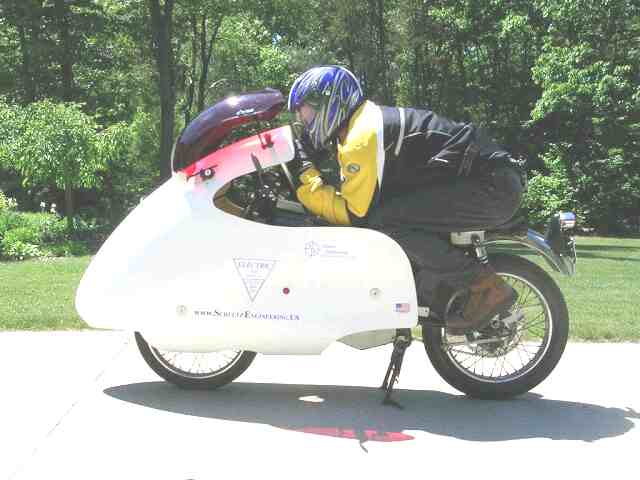|
Putting Some Miles On - Finishing a 2,400 mile test ride | ||
|
Unique Look - July 27, 2011 Everywhere we ride young people go crazy over the look of the bike. They express their desire to own a bike like this. This is how the bike looks just after the Vetter event. The soft bags that could carry 4 bags of grocerys were replaced with a large waterproof tool box (Stanley Fatmax MADE IN USA). Next steps are to use it as a commuter vehicle in west Michigan and to work at adding a tail before the weather gets too bad to ride it here in Michigan. As a side note, while doing some data gathering with the Black tool box on we recorded a new maximum speed of 69 mph on flat ground with no wind at 76 degrees F. 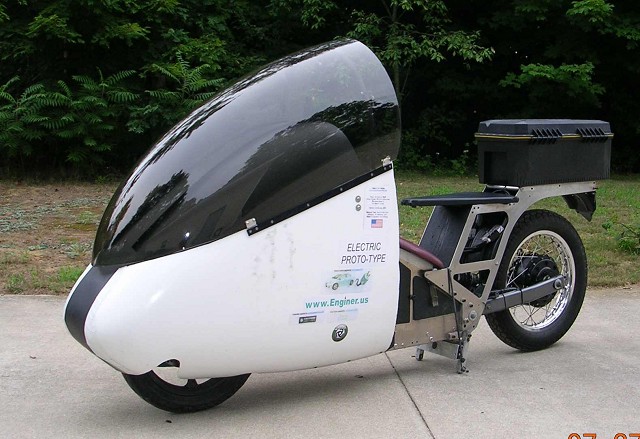 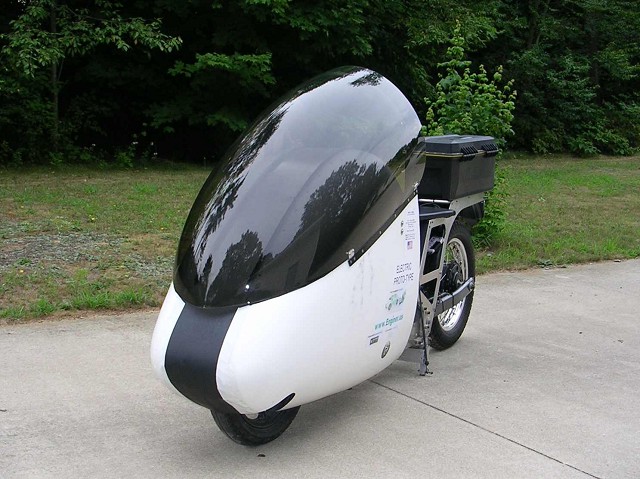 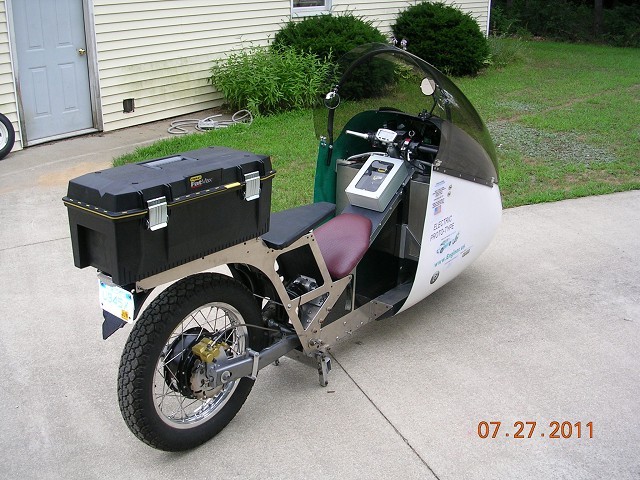 | ||
|
Success! Our 2011 bike performs better than our 2009 bike. Which bike looks more comfortable to you?
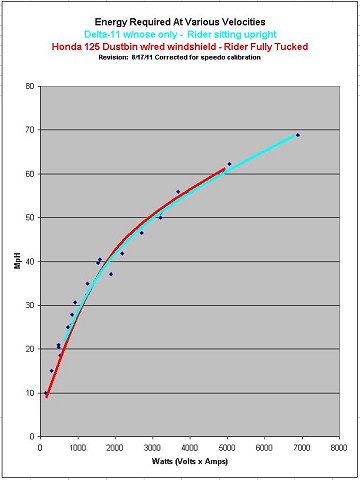 | ||
|
Best in the World? July 27, 2011 As far as we know, the Delta-11 is the 2nd most efficient electric motorcycle in the world. The only electric bike that is more efficient is Cedric Lynch's fully enclosed electric streamliner that gets as low as 20Wh/mile at 40mph. See some of his numbers at Cedric Link 1 and http://www.schultzengineering.us/aero.htm 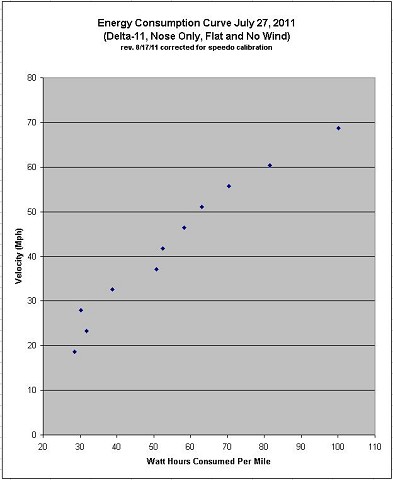 Note: This chart is for energy being used real-time by the bike. It is NOT the energy that is required to RECHARGE the bike. Recharge energy will be more because of charger and battery charging inefficiency. | ||
|
Body Work - July 30, 2011 The leading surfaces of the nose were taped in place for the Vetter challenge. Here is a picture of the nose getting fixed up with fiberglass. 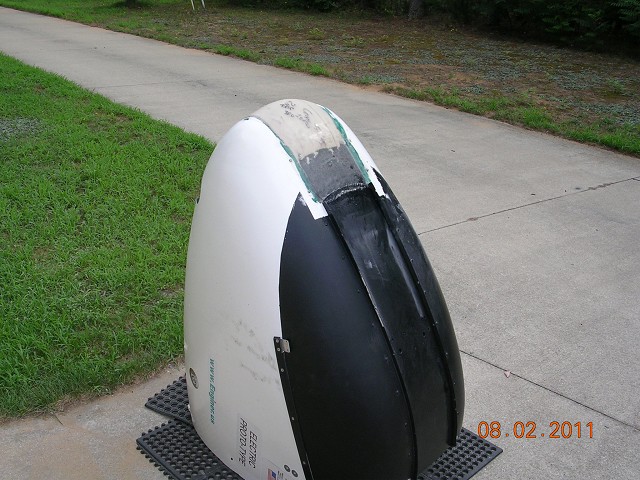 | ||
|
45 Mile High-Speed Ride - August 3, 2011 Went for a 45 mile ride (37 miles at 50 mph + 8 miles city driving) with the new nose on. I also was testing the new headlight mounted under the canopy. Recharged the batteries and the Kill-A-Watt Meters showed 3.89 kWh. So, that is a solid 86Wh/mile for REAL world driving. I made no concessions for this ride, I rode just like I'd drive my car with speeds up to 69 mph when needed in traffic, but for the most part driving the speed limit. I think the city driving is really sucking my energy due to having 200# of batteries on-board. Other things that were interesting on this ride was I rode up and down the tallest, steepest hill in West Michigan 2 times (it's called 5 mile hill because you can see five miles when you are at the top). The bike had no problem going up and regen braking kept the bike at whatever speed I wanted going down. But, going up I was always drawing 5 to 6 times more energy than I was making coming down with regen. So, regen certainly helps, but it isn't super efficient. The other thing to note, is I ran with the halogen headlight on the entire trip. The 12 volt system runs off 1/2 of the battery pack and so it is easy to see how much energy the 12volt system is using. In this ride, the 12v system used .15 kWh. So, the headlight used 3.8% of the energy consumed on the ride. 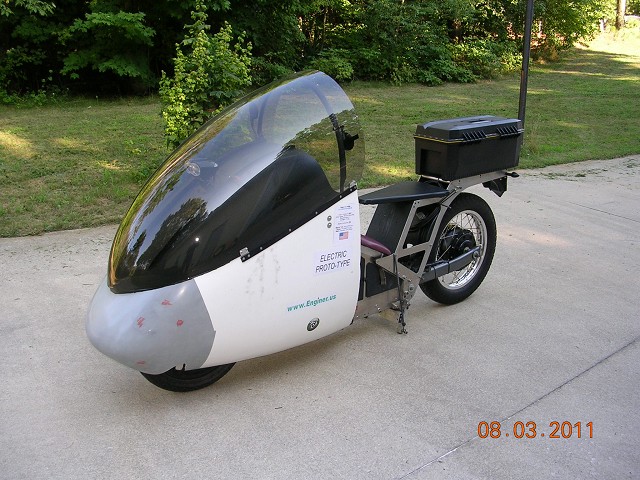 | ||
|
103 Mile Ride On a Single Charge! August 4, 2011 Did two range test rides today. Rode up to Muskegon to visit my family. The first was 55 miles at 50mph (no city driving). Used 4.6 kWh from wall to recharge for an average of 84Wh/mile.  Then, I rode north to explore 103 miles at 37mph. Used 6.36 kWh from the wall to recharge for an average of 62Wh/mile. 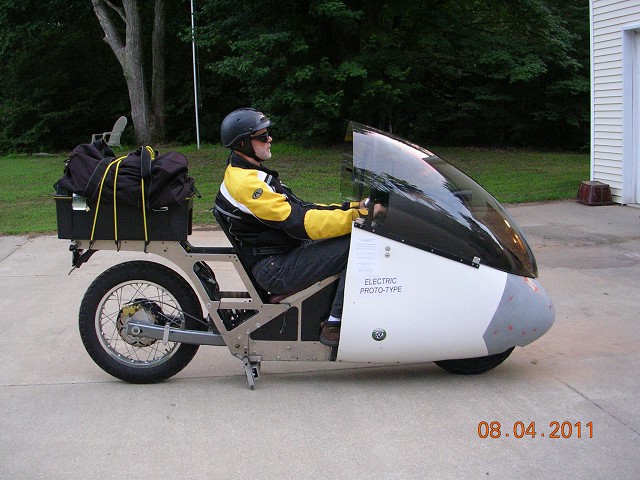 | ||
|
Max Speed Now 69.8 mph! August 8, 2011 To improve safety and handling, nose was raised up 1 inch and steering dampener was added. New Max speed: 69.8! 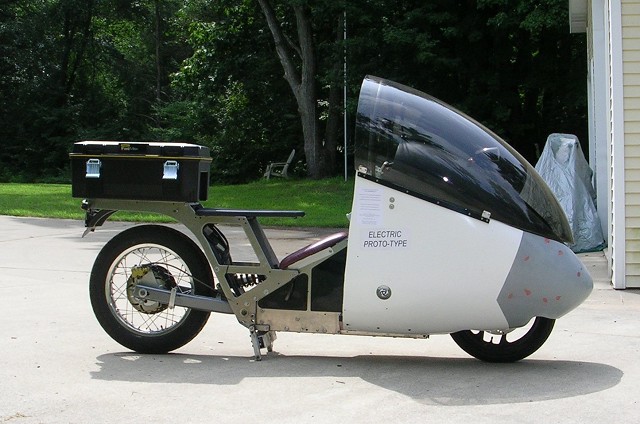 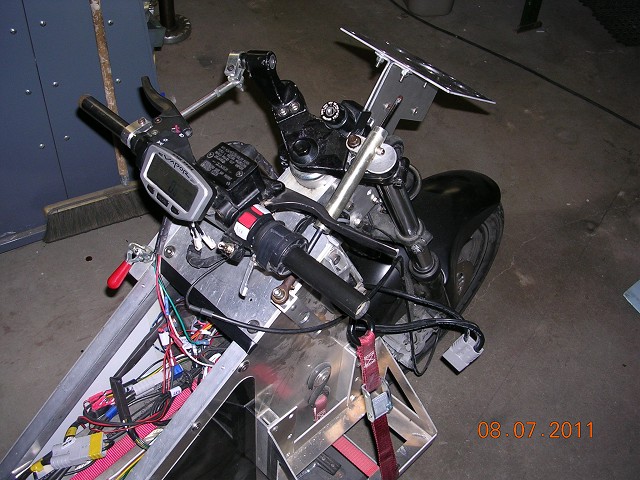 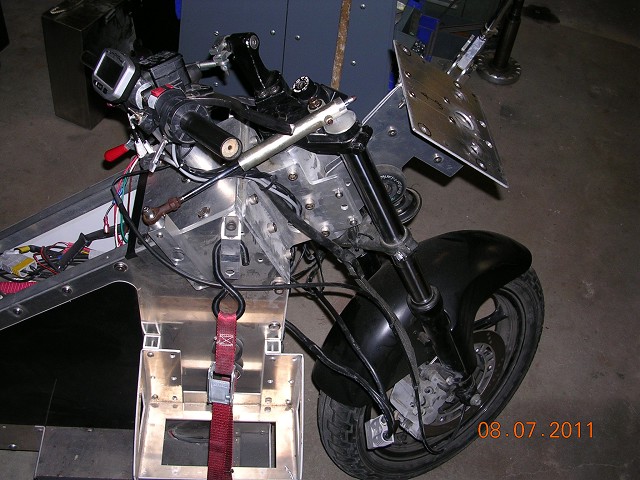 | ||
|
72 Mile Charging Station Tour August 10, 2011 Tested the J1772 Level 2 charging option today. Did an hour of charging while eating lunch and doing some shopping. Since bike was topped off and ready to roll, ran errands to stores, visited customers, subcontractors and friends. Stopped to have Motorcycle Weighed at Salvage Yard - With Chargers on board, weight is 520 lbs.! This helps explain why the fuel economy in the city is the same as fuel economy on open road going 50mph. So, 520lbs, minus 30lbs chargers, minus 200lbs batteries = 290# rolling chassis and motor. Time to go on a diet!  Here is a picture in front of the LG Chem Battery plant in Holland. 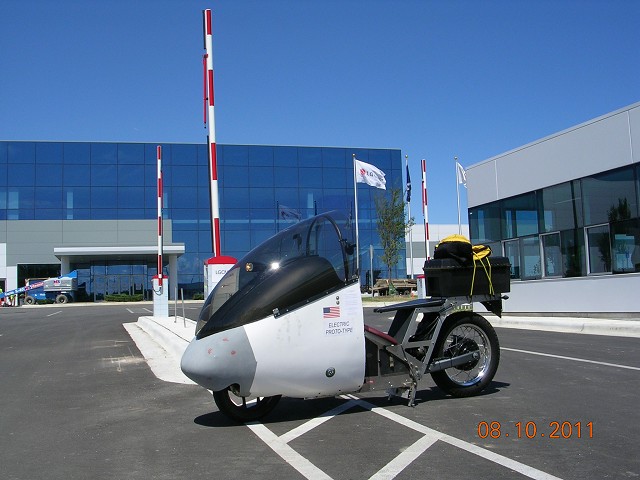 Here is a picture in front of the JCI/Saft Battery plant in Holland - President Obama will visit there tomorrow. The invitation is open for him to visit the skunk works that is designing the Worlds Most Efficient Production Electric Motorcycle strategically located within full electric range of the battery plants. 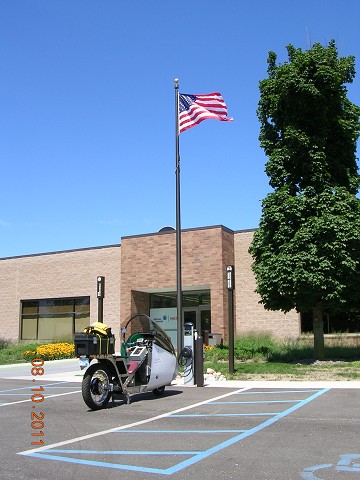 | ||
|
Fast Recharges and $.012/Mile August 12, 2011 Miles Ridden with Nose: 773 miles Electricity from Wall to Recharge: 59.4 kWh Average Watt Hours Per Mile: 77 Wh/mile Cost Per KiloWatt Hour: $.155/kWh for electricity Energy Cost / Mile: $.012/mile Note: We pay slightly more for our electricity so that it can be produced using clean, renewable energy. This a picture of the charging set-up used. There are two chargers, each consume almost 1 kW per hour. Energy consumed is measured by Kill-A-Watt brand instruments. Recharge time is about 1 hour for each 20 miles traveled at 50mph. The chargers have timers to turn them off after a certain amount of time if desired and can be run from two, standard 110 VAC household outlets or from one J1772 Level 2 charging station. The slick J1772 Adpater Box is from TucsonEV (http://www.tucsonev.com/).  | ||
|
Gurney lip August 17, 2011 Slitting a section of old garden hose, I made a Gurney lip for the trailing edge of the nose. The lip pushes what little air was getting to my face, ears and shoulders out and around me. It has had no measurable impact on fuel economy and it seems like it makes gusting crosswinds easier to handle. 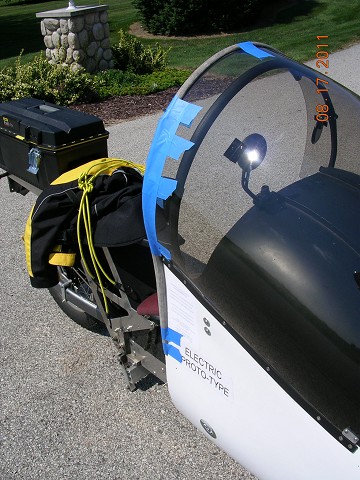 | ||
|
CAD vs. Reality Sept. 1, 2011 A picture of bike compared to the CAD model that was used to build it. 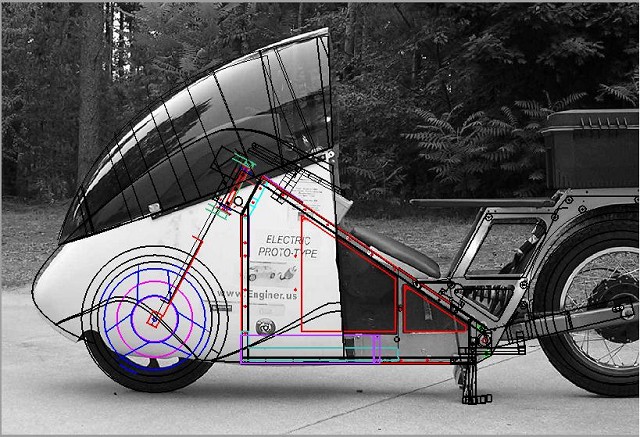 | ||
|
Non-Enclosed Motorcycle Speed Records 2010-2011 The land speed record bikes are getting more streamlined as we go. 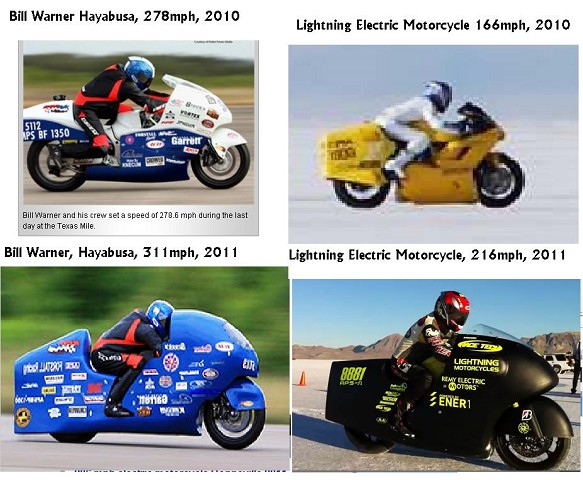 | ||
|
Paint Nose Sept. 4, 2011 Finally, painted the nose, and took a test drive without the Guerny Lip. Definately worse manners in high cross winds without Guerny Lip, will need to do experiments with making lip larger and smaller to see if more improvement can be made and also ways to make the lip look nicer. 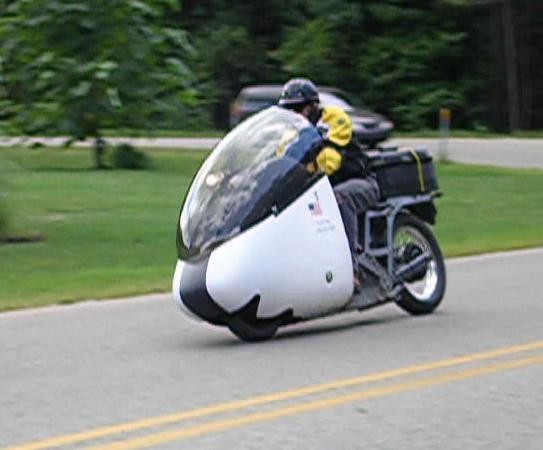 | ||
|
Finally a Video! Sept. 4, 2011 Some video of the Delta-11 prototype in action.  | ||
|
Breakdown, Ends Delta-11 Riding Season! October 11, 2011 A beautiful October day. A perfect day for our first ride interuption (breakdown). We are happy to announce our first breakdown, after the Delta-11 completed the entire summer season (2,424 miles) without a breakdown or running out of battery power during a ride (an experimental switching relay burned out). The Delta-11 (P1) bike will be disassembled to see how it is holding up and to prepare it for the 2012 riding season. 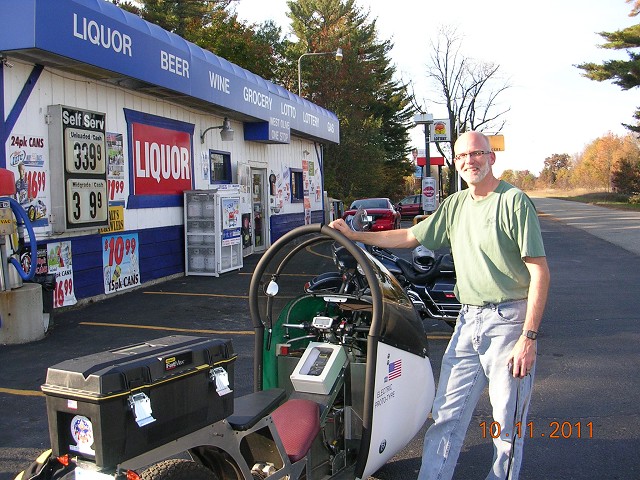 A Harley rider (see his bike in the background) heard I was broke down from his son and zoomed over to see the bike. It turns out he's seen me on the road all summer and had been trying to catch up with me. He offered to take my picture with the bike. While waiting for my trailer, several other groups on people stopped to see the bike. One group of 4 young people were so pumped up about the bike they posed for pictures with the bike! 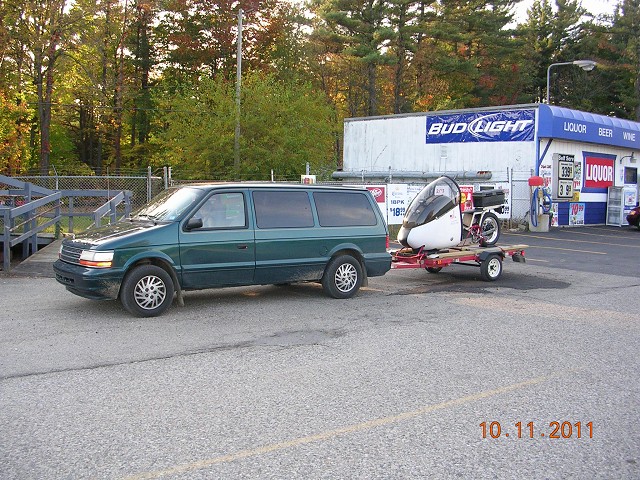 | ||
|
Lessons of the Ninja. October-November, 2011 With the Delta-11 Prototype out of service for the Winter, Kraig has been riding this 1997 Ninja 600R that was purchased to become a donar for the 2012 Delta Bike program. This has provided a great opportunity to compare riding a crotch rocket against the Delta-11. It is obvious now that side wind buffeting is more of an issue on the Delta-11 than on a standard bike. Riding in the turbulence behind Semi trucks the Delta-11 front bodywork is noticably buffeted, where on the Ninja buffeting is only barely noticeable on the upper body of the rider. The advantages of the streamlined electric bike are sorely missed. No gasoline or oil fumes, no noise, no clutch, no choke, no gears, no shifting, no wind in the face/chest/hands/knees. The comfort of the Delta-11 is replaced by pain in all the major joints (knees, elbows, neck and shoulders)... Missing is the low cost per mile and the JOY IN RIDING at any speed. There is a threshold where gusting crosswinds are dangerous even on a normal bike. When gusting cross winds exceed 30mph they can really start to push you around. The problem is when they catch you unexpected and throw you off balance it's hard to do the right thing - COUNTERSTEER! A 30mph gust is the kind of gust that will catch you when standing up on the ground and make you take a step backwards because it hits you hard. It's also the kind of wind that makes you wonder if your bike might tip over in the parking lot. The secret of dealing with these conditions is to be ready to countersteer strongly and quickly enough to immediately tilt the bike into the wind. Also riding crouched over close to the bike helps reduce the power of the wind acting on you (because the cross winds are mostly grabbing at the torso of the rider on a regular bike). On the Delta-11 there is no crouching over, the bike is always the same height and has much more surface area than a regualr bike, so in wind gusts as low as 25mph it starts becoming scary. To measure wind forces, we use a great little wind gage from Dwyer-Instruments. It has instantaneous response to wind gusts and can measure windspeeds from 0 to 60 mph. It takes no batteries and it only costs $20. http://www.amazon.com/Dwyer-Instruments-Hand-held-Portable-Instantly/dp/B0019H84JW/ref=cm_cr_pr_product_top. 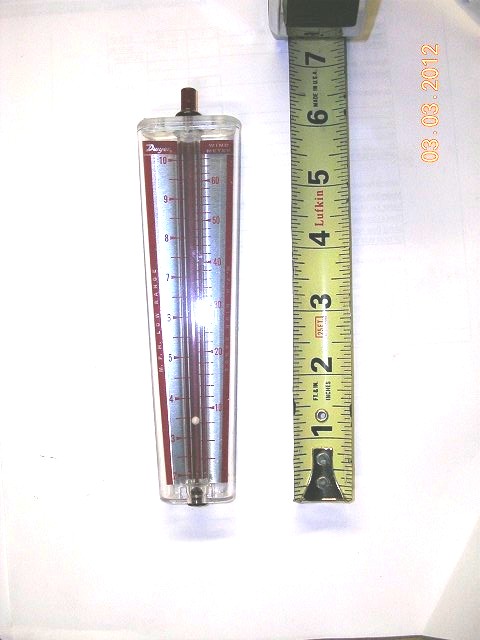 Probably the most interesting thing we've learned from the wind gage is that the same type of gust that tosses a bike around while riding (25-30mph gusts) creates scary tipping forces while stopped on the side of the road. So, really we can do all kinds of experiments with wind gusts with less risk of crashing...by just sitting on the side of the road balancing the bike with our feet. Passing traffic creates disturbances in the wind patterns just like when riding. 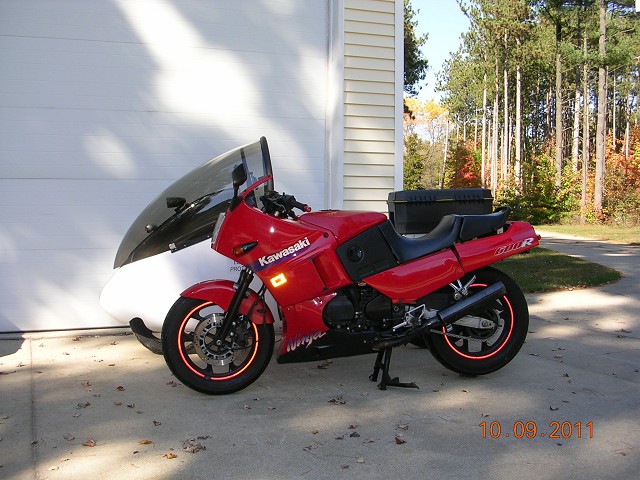 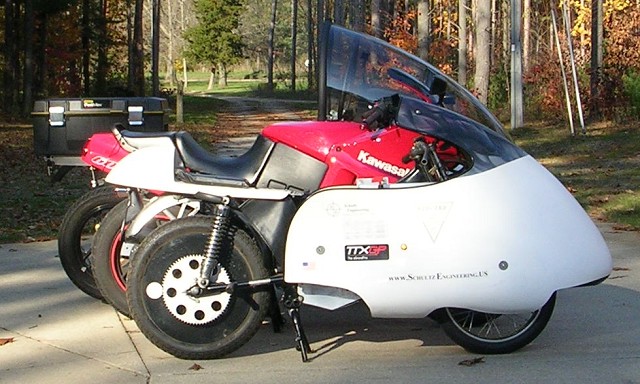 | ||
|
We rode the Delta-11 proto-type 2,400 miles this Summer. How did it do for fuel economy? Oct. 11, 2011 Here is some of the data collected since the nose was installed on the Delta-11 bike.  2011 Summary of Nose Only Performance: Miles Traveled with Nose on: 1975 miles Kilowatt Hours Drawn from Wall: 168.5 kWh Watt Hours Per Mile: 85.3 Wh / Mile (395 MPGe) Average Distance / Trip (55 Trips): 39.5 Miles Energy Cost / Mile: 1.3 pennies | ||
|
ESTIMATED EPA MPGe November 1, 2011 The following Wikipedia article outlines how MPGe is calculated for Hybrid and Electric cars. See http://en.wikipedia.org/wiki/Mpge. The formula is MPGe = (33,705 watt hours/gallon of gas) / (watt hours/mile consumed during EPA's 5 drive cycle tests for electric cars) Now, we did not do the EPA's 5 drive cycle tests, so the following number are only projections of MPGe for the Delta-11. If our Delta-11 were to get 70 Wh/mile in the EPA tests, it would have the equivalent of 481 MPGe. If our Delta-11 were to get 80 Wh/mile in the EPA tests, it would have the equivalent of 421 MPGe. If our Delta-11 were to get 90 Wh/mile in the EPA tests, it would have the equivalent of 374 MPGe. If our Delta-11 were to get 100 Wh/mile in the EPA tests, it would have the equivalent of 337 MPGe. With the Aerodynamic nose on the bike, we averaged 85.3 watt hours per mile in 1,975 miles of REAL WORLD riding. That is the equivalent of about 395 MPGe. | ||
|
1,000 MPGe IS POSSIBLE! November 13, 2011 Is 400 MPGe good? We are shooting for a 100 mile range at 55mph. This is the equivilant of about 800MPGe with our current battery pack. But, is reaching this goal even possible? To answer this question, we did some calculations based on the assumption that we can't do better than the NSU flying hammack that had a Coeficient of Drag Cd=.1. These calculations indicated that our bike currently has a Cd of about .65 and that we could get around 1,000MPGe with a Cd=.1. To hit our goal of 800MPGe, we will need a Cd=.15. For reference, Craig Vetter's yellow streamliner has an estimated Cd=.45. So, while possible, it will be hard to achieve on a non-fully enclosed vehicle. To see the calculations, visit the following link: http://ecomodder.com/forum/tool-aero-rolling-resistance.php (Next Page) | ||
|
Inventing a better tomorrow today... Copyright 2010-2011, Schultz Engineering, LLC |

